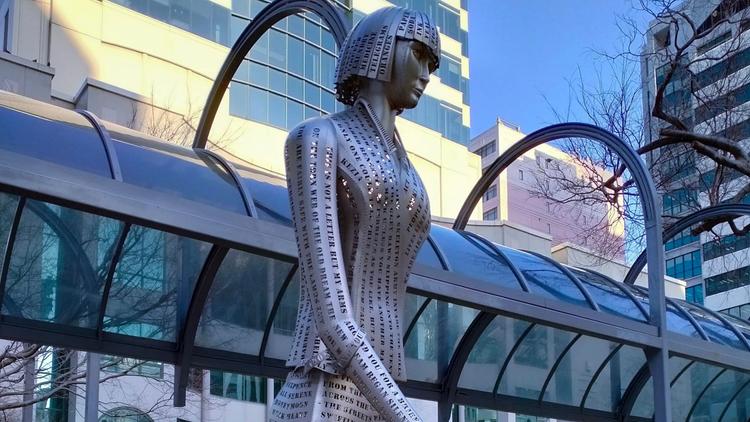Wellington's Lambton Quay is home to an eclectic assortment of art, sculptures and statues. Ranging from the genteel figures of John Plimmer and Fritz and the ingenuity of Invisible City, to the urban fossilisation of Shells, the motionless denizens of the CBD make for an evocative gallery for the everyday passer-by. However, one of the most striking figures in the city is that of the gleaming Woman of Words. Standing at an impressive 3.3 metres tall, the statue of Katherine Mansfield watches over pedestrians and shoppers passing by on the footpaths below with an inscrutable expression, artificial lights flickering through the snippets of text laser cut into the statue’s skin.
Born on Tinakori Road, Thorndon, on the 14th of October 1888, Katherine Mansfield was the third daughter of Annie and Harold Beauchamp. Despite a relatively happy childhood spent in Wellington, three years in London for schooling from 1903 left her feeling stifled and rebellious upon her return home to Aotearoa, and she longed to escape the confines of her family and upper-class society. While Mansfield was initially determined to make a living as a professional cellist (Mansfield was proficient at the instrument, and the statue’s elongated hands are intended as a reference to her musical past), she was a writer from a young age and went on to earn international acclaim for her artful and clever Modernist prose. To this day, Mansfield’s legacy forms an integral part of the Wellington literary and heritage scene, with the Katherine Mansfield House & Garden being a popular stop along Tinakori Road.
Designed by Auckland-based sculptor Virginia King, the statue installation is the result of a three-year collaboration between the Katherine Mansfield Society, Wellington Sculpture Trust, and Wellington City Council. A leading New Zealand artist, King’s oeuvre features an aesthetically-complex focus on the incorporation of text into sculpture. Consequently, King was particularly well-equipped to tackle the literary history and themes behind the work, and did so while keeping in mind Mansfield’s notable tension between her own identity as both a writer and a woman. While it was Mansfield’s keen ambition to be seen as ‘a writer first and a woman after’, the multidimensionality of her work and life are equally celebrated in King’s work. This includes a juxtaposition between the high- and low-brow aspects of her writing: While the laser cut quotations from Mansfield’s stories and journal entries can be clearly seen on her dress and body, the inclusion of Mansfield’s grocery lists on her hair can be overlooked by the casual observer.Woman of Wordsis constructed from marine grade 316 stainless steel, and combines the reflective quality of the metal with amber lights set at the statue’s base, creating a dynamic, mirrored figure in the daytime, and an illuminated wonder throughout the night.
The addition of Woman of Words to the streets of Wellington was met with largely positive reviews from the community, with Neil Plimmer (Chair of the Wellington Sculpture Trust) describing the artwork as a significant new addition to the city’s collection of world class public art, and a worthy ode to one of Wellington’s most renowned daughters. While the statue has become a key emblem of Wellington’s literary and artistic scene, it has also raised questions around gender and heritage in the capital city. Of over 150 public artworks in the city, 18 of those are statues. Of those 18, a shockingly low total of 2 statues are literal depictions of a singular female figure (Woman of Words on Lambton Quay, and the statue of Queen Victoria on Kent and Cambridge Terrace). While there is a limited number of women appearing in other artworks, they appear either as secondary figures (such as Hine Te Apārangi in the Kupe Raiatea/Kupe’s Group statue on the waterfront), or as the embodiment of an idea (such as the Hinerangi statue in Pukeahu War Memorial Park). While there is no single entity to blame for this imbalance, a city’s culture and values are communicated in its architecture and artworks, and it is vital that this inequality be acknowledged and addressed. However, the statue of Katherine Mansfield provides a striking presence in the city’s public art scene, and will surely lead the way for the design and installation of artworks to come.
As an ode to one of Wellington’s most renowned writers, Woman of Words is an apt emblem for the moving and complex story of Katherine Mansfield. Proudly overlooking Lambton Quay, the statue stands as a reminder of the enduring history and culture that has built our capital city, and continues to thrive to this very day.
The Katherine Mansfield House & Garden are hosting a guided walking tour at this years festival! Explore the Thorndon the Mansfield knew and the traces of her legacy that remain in the landscape today. Book the tour here or visit our events page to see more!
SOURCES:
https://www.ncwnz.org.nz/where_are_the_women_wellington_s_statues_have_a_gender_problem
http://www.stuff.co.nz/dominion-post/capital-life/8650513/Mansfield-statue-at-the-park
